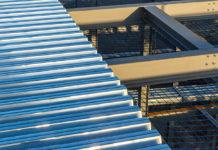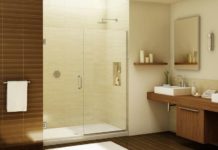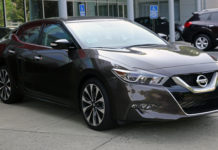Ever since a person began to build dwellings for himself, it became necessary to regulate the amount of light entering the room, as well as to hide from prying eyes everything that is and is happening in the house. These tasks are easily accomplished with devices such as blinds. The editors of the site "bestx.htgetrid.com/en/" will tell you about the design features, selection criteria and the advantages and disadvantages of various types of blinds.
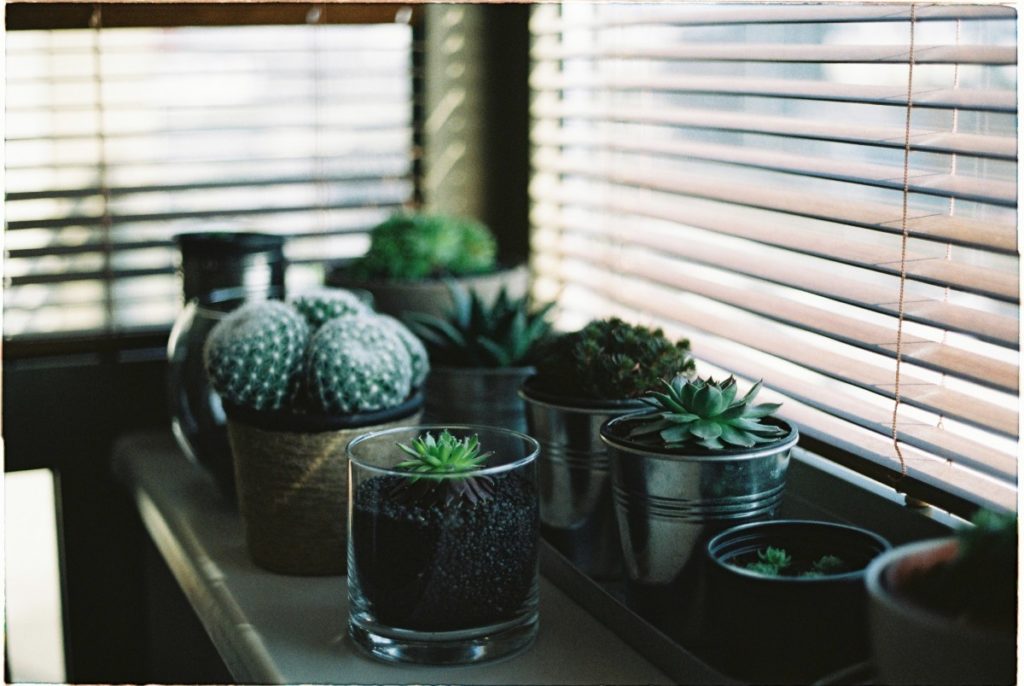
Content
A bit of history
Most likely, such "clothes for windows" as blinds, originates in countries with warm climates located in Asia, the Middle East, the Mediterranean and South America. They rarely used glass in window openings, replacing them with wooden planks fixed at an angle in the window opening, horizontally or vertically, or used curtains made of plant stems tied together with ropes, which could be rolled up, thereby regulating the illumination of the room.
These devices were much more durable and practical than fabric curtains in conditions of high humidity, provided air circulation, regulated the illumination and heating of the room with sunlight, made it possible to quite freely see what was happening outside and at the same time saved unauthorized persons from entering the house through the window openings. Of course, they weren't called “blinds” yet.
The production of blinds was officially patented in 1841 by the American industrialist John Hampton.
The word jalousie (jalousie) is of French origin and translates to “jealousy”. It is assumed that the history of this name goes back to the traditions of the East, where such designs were used on window openings, and there were strong traditions of hiding women from prying eyes. In Europe, blinds became very popular among courtesans, who intrigued men with small boards on strings, showing and hiding their bodies at the same time.
Over time, the designs of the blinds have been improved, new materials and new opportunities have appeared, which make it possible to implement the most daring design ideas for the interior arrangement. Combined with ease of maintenance and use, blinds eventually became very popular all over the world.
What are the blinds
Horizontal blinds
These are blinds consisting of thin lamellas located one above the other, tied together by cords, which allow the lamellas to rotate around their axis, adjusting the permeability, and also rise and fall with fixation at the required level.
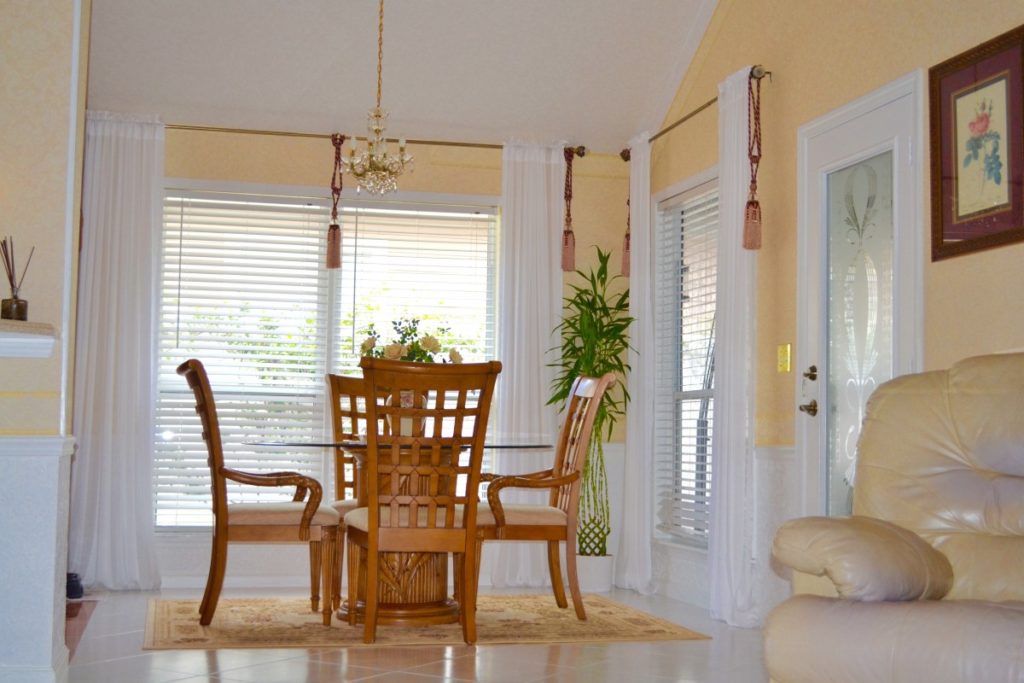
Slats are made of dense materials - metal, aluminum, plastic, wood. The color range of such blinds is limited by the buyer's imagination and the manufacturer's capabilities. Application of photo printing is possible. Photo printing on translucent plastic blinds on a sunny day creates an interesting glowing picture effect.
Planks made of aluminum, metal and plastic are prone to deformation, creases and require careful handling. Wooden lamellas are negative for high humidity.
There are three ways to install horizontal blinds:
- on each casement of the window;
- into the window opening;
- on a window opening to a wall or ceiling.
If all your window sashes open, then the installation of horizontal blinds on the alignment does not even require drilling. There are special hooks-brackets that allow you to fix the blinds on the sash.
Installing blinds in the window opening allows you to save space, but this solution is justified only with deep window openings, when there is enough space to open the window when the blinds are closed without the risk of damaging them.
Very often recently, such blinds are installed inside a glass window. This decision has a lot of positive aspects. Firstly, dust and dirt do not accumulate on the lamellas and they do not need to be washed, since the glass unit is sealed. It is simply the perfect solution for those suffering from allergies. Secondly, no matter what position the blinds are in, open, closed, lowered or raised, this will not interfere with the opening of the window itself to ventilate the room.
This design will not sway from a draft, bothering the inhabitants of the apartment with methodical noise, especially at night. Thin lamellas, being inside the glass unit, are protected from accidental damage. The service life of windows with double-glazed windows with built-in blinds, according to the manufacturers, can last up to 80 years, but this is the most expensive option for installing blinds.
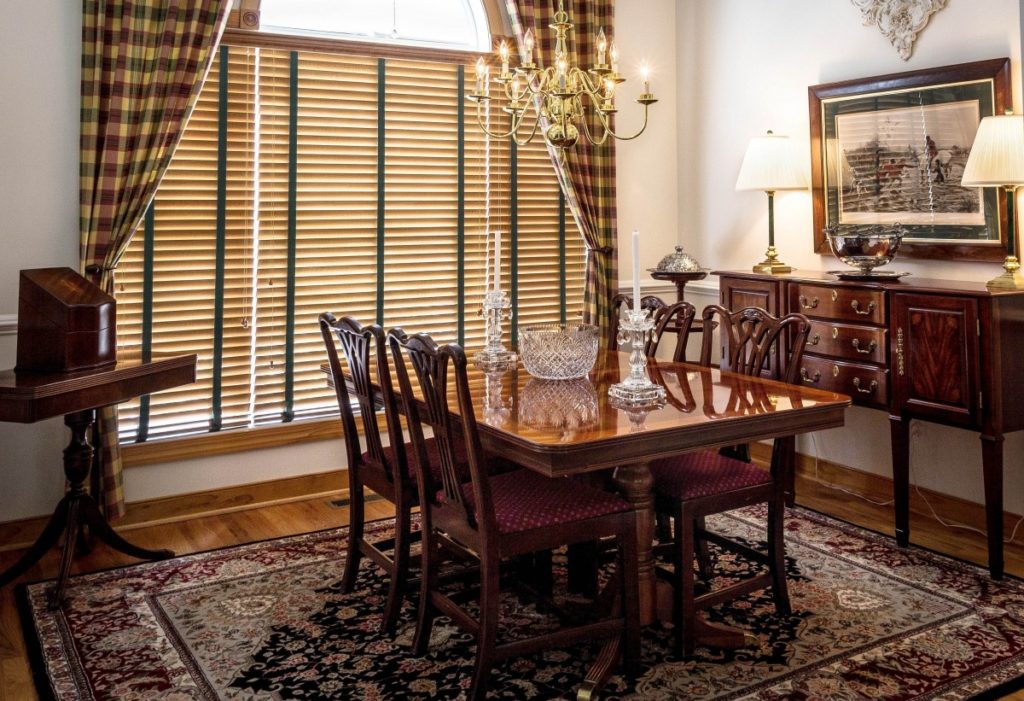
Benefits:
- Simplicity of construction;
- Ease of installation;
- Almost unlimited possibilities for color solutions.
Disadvantages:
- Thin lamellas made of plastic, aluminum and metal are susceptible to damage;
- They create unpleasant noise in drafts.
Popular manufacturers
- DDA. The average cost of blinds 60 cm wide with plastic slats is 490 rubles.
- Escar. The average cost of blinds 60 cm wide with plastic slats is 507 rubles.
- Online store Master plus. The average cost of blinds 60 cm wide with aluminum slats is 806 rubles.
Vertical blinds
These blinds have wider slats than horizontal ones. The planks are located vertically and can, depending on the selected mechanism, move to one side of the cornice or from the center to both sides of the cornice.
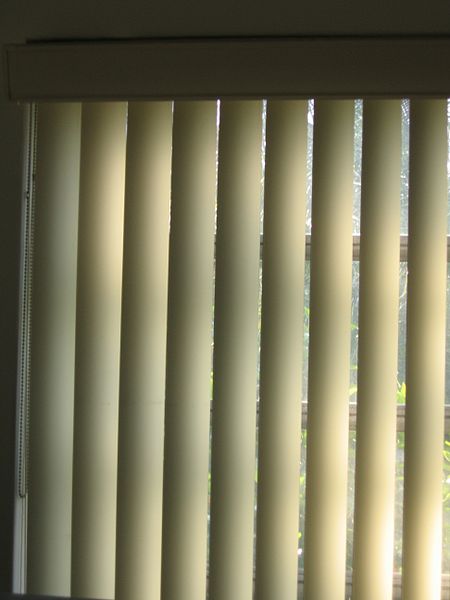
The width of the overlap depends on the length of the cornice and can be not only the width of the window opening, but also from wall to wall. Rope or thread vertical blinds with slats from ceiling to floor covering the entire wall, which can change the image of a room in a matter of minutes, look especially impressive.
The height of vertical blinds is determined at the stage of ordering and manufacturing and is not adjustable during use. The height can be from ceiling to floor, or with partial or complete overlap of the window opening, wave, steps, semicircle - it all depends on imagination and desire. In addition, a mechanism hidden in the cornice allows the planks to be rotated 180 ° to one side or the other.
By installing strips with a different color and texture on each side, you can get two different images of the blinds, turning them with one side or the other inside the room.
This effect will be especially interesting in a children's room, allowing you to change the setting from a strict room for homework to a playroom. In the manufacture of vertical blinds slats, fabric, plastic, ropes, threads are used. The ability to combine various materials, colors, use all kinds of decor open up wide opportunities for creating an individual and unique element of the room. Also, very often vertical blinds are used in interior doorways instead of doors.

Benefits:
- Wide possibilities for combining materials and colors;
- Ease of installation;
- Not prone to accidental damage to the strips;
- Simple controls.
Disadvantages:
- More complicated and time consuming process of washing and cleaning in comparison with other types of blinds.
Popular manufacturers
- Verend-Design company. The average cost of blinds measuring 100x100 cm with plastic slats (measurement + delivery + installation) is 1490 rubles.
- Online store Jaluzi-Shop.ru. The average cost of blinds measuring 100x100 cm with plastic slats is 1,500 rubles.
- Online store Master plus. The average cost of 130x150 cm blinds with plastic slats is 3311 rubles.
Roller blinds
Roller blinds are a mechanism that resembles a cornice with a shaft on which cloth, bamboo cloth, impregnated paper cloth, film or thin plastic are wound in a roll.
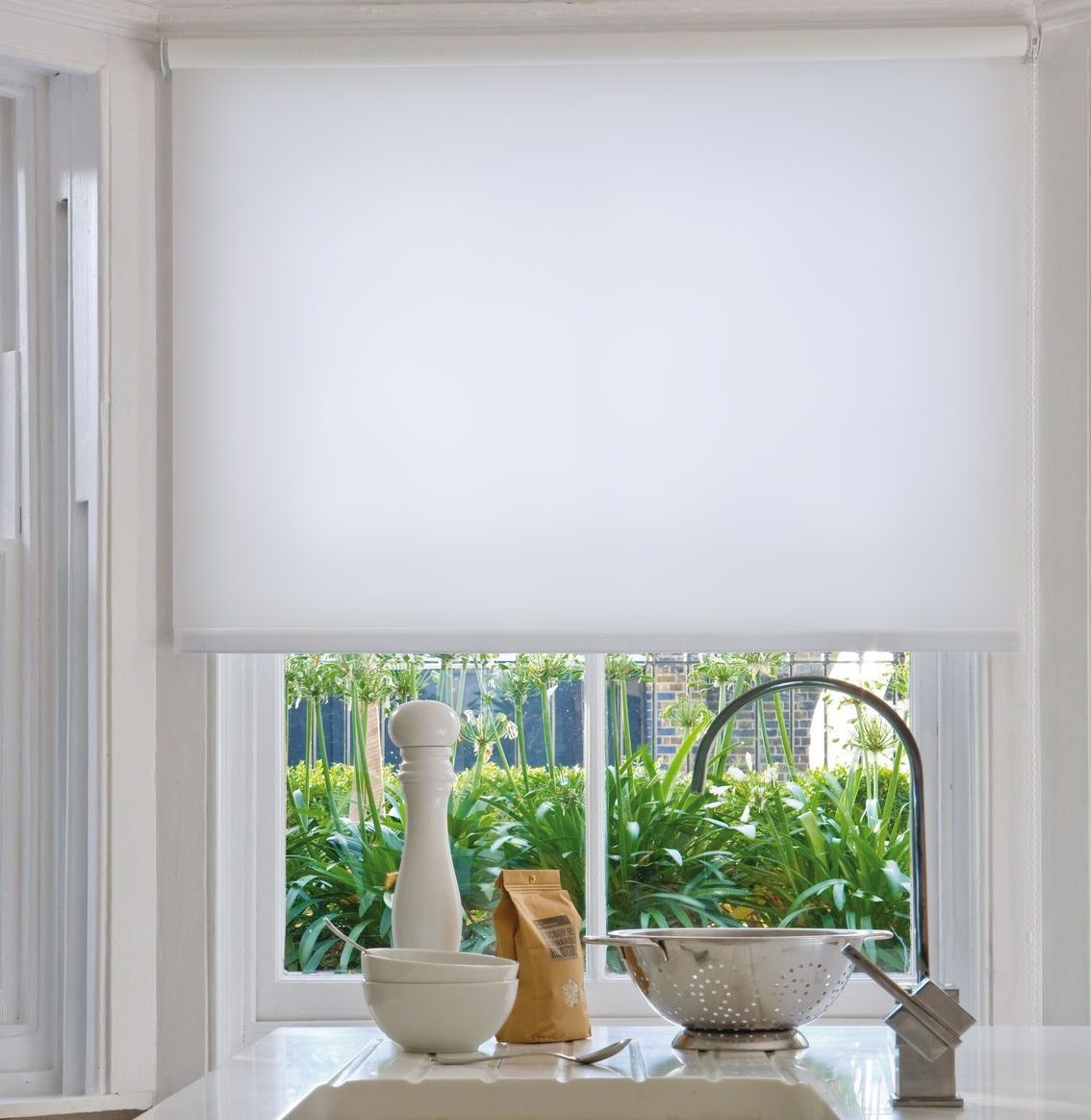
This is probably the most inexpensive and easy-to-use type of blinds. Very often they are sold in hardware stores and differ from each other in the width of the web, the degree of light transmission and the type of material of the web. Having bought roller blinds of a standard width, you can effortlessly adjust their size to a specific window sash by carefully cutting the end of the canvas and shortening the shaft of the mechanism. In this case, the curtain will retain its functionality.
Roller blinds are installed with a tight fit of the canvas to the window frame or the end of the window opening, which allows you to effectively control the illumination of the room, up to its complete darkening using a screen made using the Black Out technology.
Benefits:
- Availability;
- Low price;
- Ease of installation;
- Simple controls.
Disadvantages:
- Low reliability and durability.
Popular manufacturers
- DDA. The average cost of a roller blind (width 62 cm, fabric material polyester, no box, installation without drilling) is 750 rubles.
- Escar. The average cost of a roller blind (width 60 cm, fabric material is bamboo) - 468 rubles.
- Online store Master plus. The average cost of a roller blind (width 60 cm, linen fabric) is 1537 rubles.
Pleated
This type of blinds, on the one hand, can be the simplest in design, but at the same time it can be a very stylish window element. Pleated blinds got their name due to the fact that they look like a material gathered in folds.

For their manufacture, paper, fabric, plastic of various densities and textures are used. These blinds can be closed upwards or, when installed at the bottom and at the top of the window, closed simultaneously in opposite directions. This feature is useful for ground floor windows. Choosing for this method of installation blinds from materials of contrasting colors, textures or properties, you can get an interesting effect of dividing the window into two halves.
For non-standard windows (triangle, semicircle, trapezoid), pleated blinds are the only possible option for blinds. Due to its low weight, only pleats can be installed on ceiling and roof windows. There are options for pleated blinds with two screens made of materials of different densities and colors, moving independently of each other, allowing you to effectively control the degree of illumination of the room. They are also called “Day-Night”.
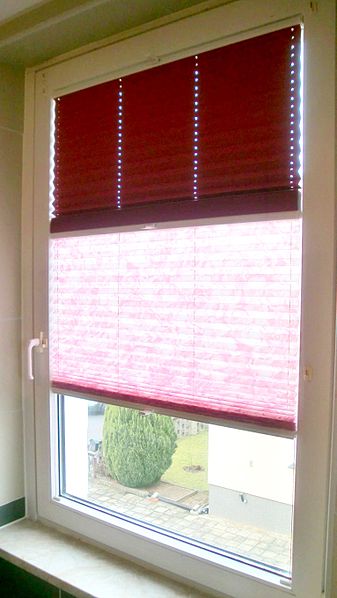
The use of screens with a honeycomb structure, where two layers of folds are glued together to form voids in the open state, can significantly reduce the flow of heat and noise into the room. In addition, having a great desire and time, you can make pleated blinds with your own hands by finding instructions on the Internet.
Benefits:
- Simplicity of construction;
- Suitable for non-standard windows;
- Can be closed from bottom to top.
Disadvantages:
- Fragility.
Popular manufacturers
- Redi Shade. The average cost of pleated blinds (width 91 cm, material paper, installation without drilling) is 570 rubles.
- Verend-Design company. The average cost of pleated blinds (width 60 cm, material fabric without a pattern, it is possible to open from bottom to top and top to bottom) - 4080 rubles.
- Online store Master plus. The average cost of pleated blinds (width 60 cm, material is dense fabric without a pattern, it is possible to open from bottom to top and from top to bottom) - 4235 rubles.
Roman curtains
This is another kind of horizontal blinds. Someone might say that this is not so, but the lifting and fixing system of Roman blinds is identical to horizontal blinds, and the functionality is very similar to the functionality of roller blinds and pleated blinds.
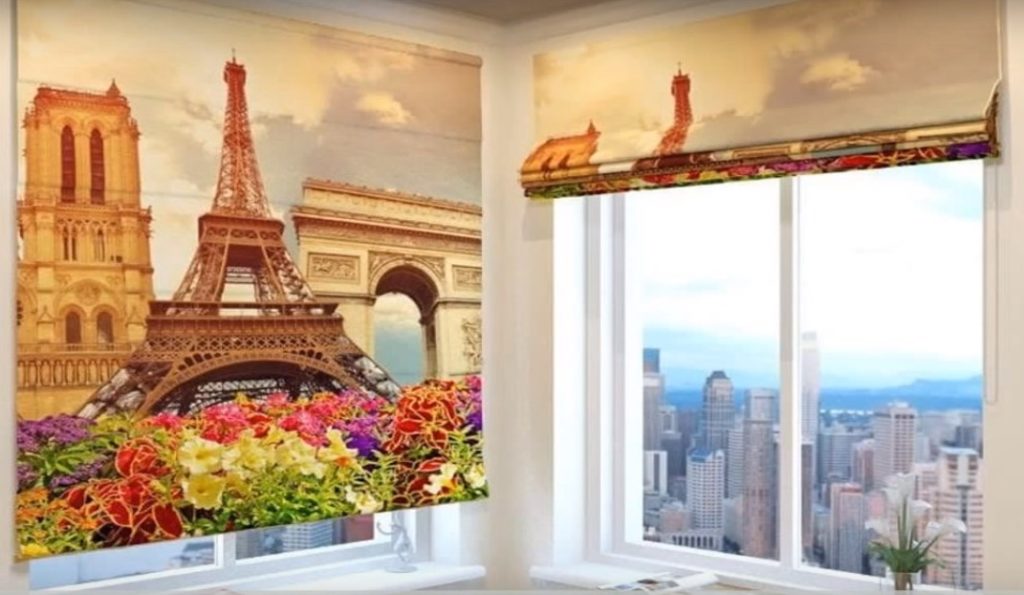
Yes, they do not look like classic blinds, but in vertical blinds with curtain lamellas it will be difficult to guess classic blinds.
There are several options for Roman blinds:
- frameless;
- classic;
- cascading.
Frameless ones do not have a rigid frame and, when adjusted in height, are assembled into a free assembly. Classic Roman blinds have rigid elements in the structure, allowing, when the curtains are fully closed, to receive a flat screen that covers the entire window. Cascading - when fully lowered, the curtains remain a bright independent element of the interior, attracting attention due to the effect of volume created by fabric assemblies similar to a cascading waterfall.
It should be borne in mind that the variety of color and texture solutions that are possible in the manufacture of Roman blinds will allow you to create truly exclusive clothes for your window. Roman blinds are installed, basically, the same way as other types of blinds - on each casement; into the window opening; on the window opening.
There is a variant of Roman blinds "Day-Night" with two independently controlled canvases: dense and transparent.
Benefits:
- Can be combined with classic sliding curtains;
- A wide selection of colors, patterns and textures;
- An effective independent interior element.
Disadvantages:
- Sometimes, when lifting the panels, not all folds fit as smoothly as we would like and they have to be corrected.
Popular manufacturers
- DDA. The average cost of a Roman shade (width 60 cm, fabric material is polyester) - 1150 rubles.
- Escar. The average cost of a Roman shade (width 60 cm, fabric material is bamboo) - 952 rubles.
- Curtain at the house. The average cost of a Roman shade (width 62 cm, linen fabric) is 2856 rubles.
External roller shutters
In essence, these are the same roller blinds with steel or aluminum strips, assembled into a single canvas, installed from the outside of the room.

Despite the fact that this type of blinds is able to solve problems of regulating the illumination of a room, they have, in our opinion, one big drawback: they not only effectively hide what is in the room from prying eyes, but also almost completely hide the outside world from the eyes of those who are present within. That is why the main function of these blinds is to protect against negative impact and penetration from the outside, and they are installed on window and door openings of office and retail premises.
The sheet from the aluminum foam-filled profile has good heat and sound insulation properties, and is significantly lighter in comparison with steel structures. The steel plate has high rigidity and excellent resistance to external influences.
Benefits:
- Durability;
- High degree of protection against external influences.
Disadvantages:
- Complexity of installation.
Raf curtains
Outwardly, these systems are very similar to horizontal blinds. Their main feature is that they are installed from the outside of buildings and, therefore, the requirements for the rigidity of structural elements and their resistance to external factors, such as temperature, moisture, wind, are much higher.

Installation from the outside of the window allows you to effectively dissipate solar thermal energy along the lamellas in the summer season. As a result, the room temperature drops by 6-8 degrees, which saves on air conditioning. In winter, on the other hand, heat loss is reduced thanks to external blinds. In addition, such systems reduce indoor noise in buildings located near busy highways. Ideal for country houses.
Benefits:
- Durability;
- Reliability;
- Efficient dissipation of heat energy in summer with its conservation in winter;
- Noise protection;
- Effective room lighting control.
Disadvantages:
- Complexity of installation;
- High price.
How to control the blinds
There are two ways to control the blinds: manual and motorized.
The manual method involves controlling the blinds with all kinds of cords, ropes, chains and requires some care to avoid tangling the controls.
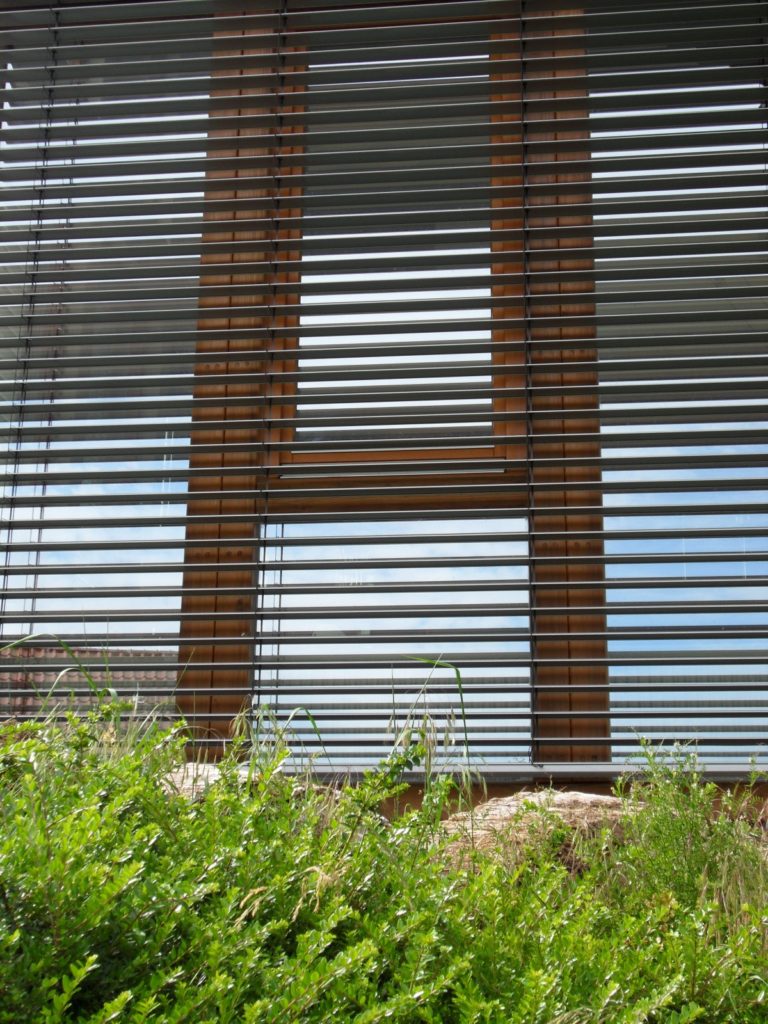
The motorized drive consists of an electric motor and a gearbox to obtain the required speed of the shutter controls and therefore requires additional installation space. The motorized drive adds a certain amount of comfort when using the blinds, but does not in any way affect the functionality of the system as a whole. In addition, the motorized drive allows you to set up remote control of the system using control panels or through a computer with limited access to the window (installed furniture, skylight).
The cost of the system itself with a motorized drive and the cost of its installation will be higher, since the installation of such a system requires not only connecting and adjusting the drive, but also bringing the wiring to the installation site.
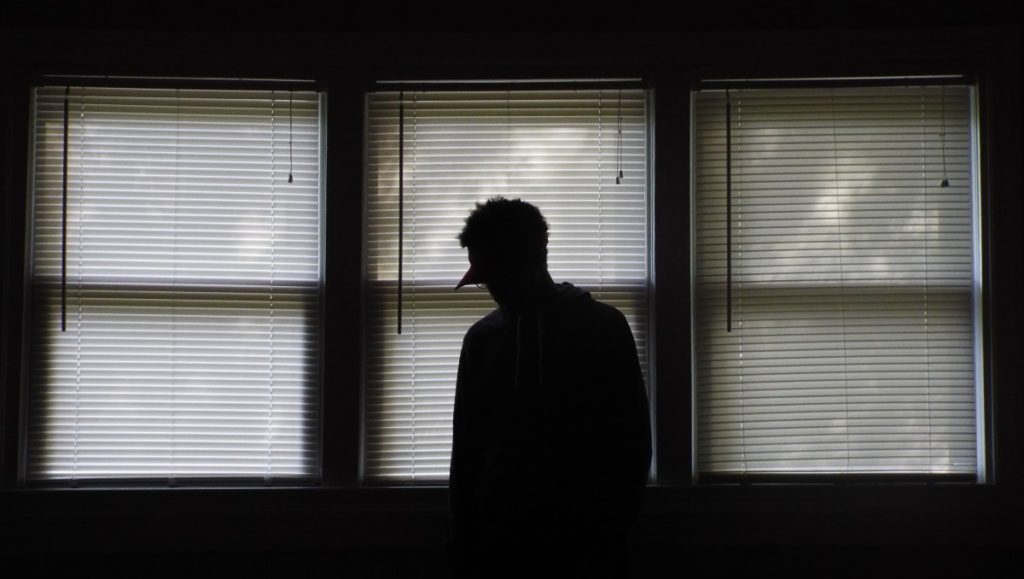
Selection of materials for the manufacture of blinds for various types of premises
The material for the manufacture of blinds must be selected depending on the conditions in which they will be installed.
For the kitchen, plastic horizontal or vertical blinds are more suitable (vertical ones are preferable, since they have wider slats and are easier to clean), roller blinds or pleated blinds with fabric or plastic screens.
In rooms with high humidity (pool rooms, showers, bathrooms), horizontal blinds with plastic slats, roller blinds or pleated blinds with plastic screens are more suitable.
For unheated places, such as verandas, balconies, loggias, with large temperature differences and a lot of direct sunlight, blinds with metal slats or with fabric screens that are resistant to fading are more suitable.
For children's rooms, blinds with fabric elements that do not create noise and are easy to wash are suitable, or pleated systems with inexpensive paper screens that can be quickly replaced when dirty.
In living rooms, Roman blinds or vertical blinds with fabric, rope or thread slats are better suited.
If you have already installed blinds in your house or apartment, share your opinion about the selected type and manufacturer in the comments.

